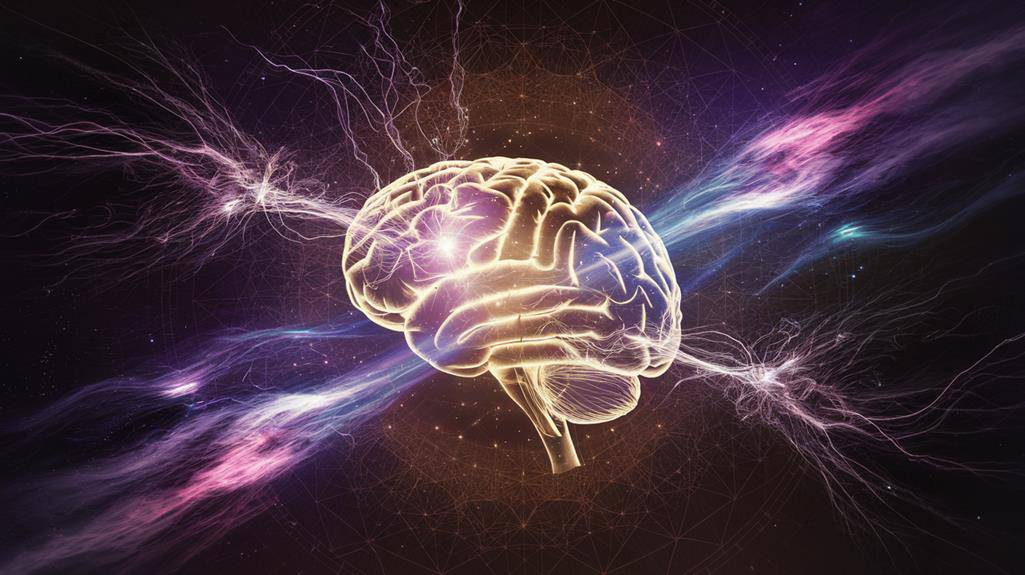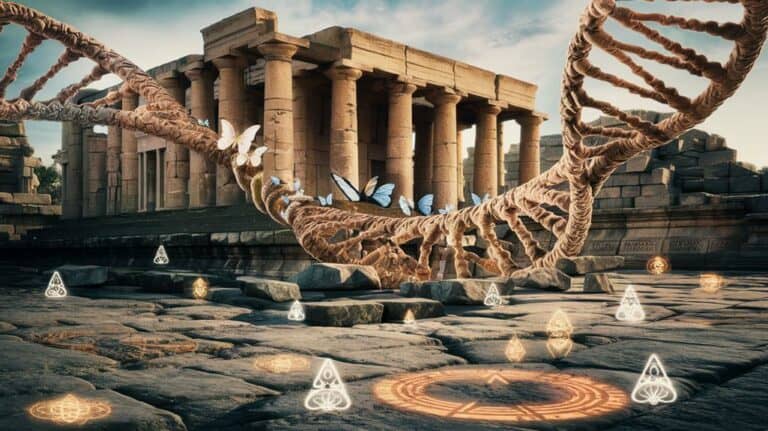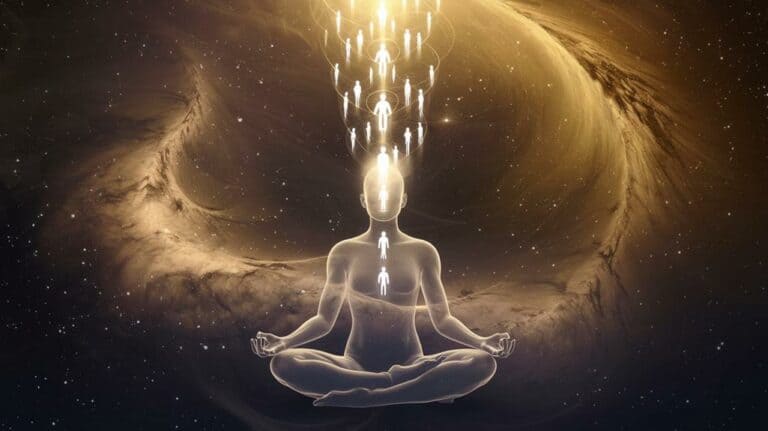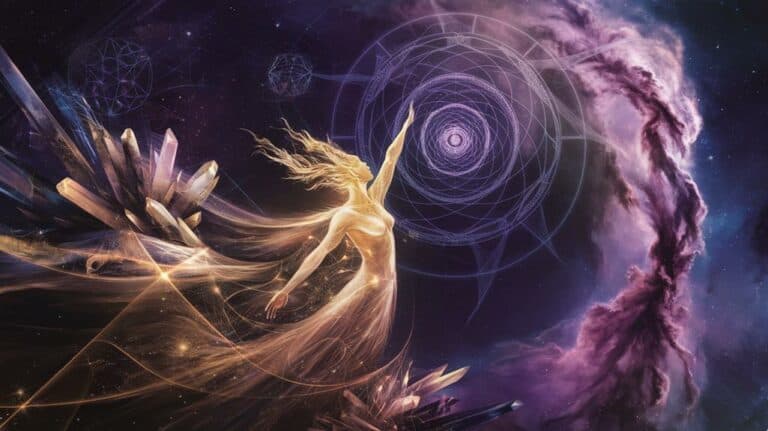The Neuroscience of Mysticism
You’ve probably experienced moments of profound awe or transcendence that seem to defy explanation – perhaps while gazing at a starlit sky or during deep meditation. These mystical states, once confined to the domain of spirituality and philosophy, have now captured the attention of neuroscientists who’ve discovered distinct patterns of brain activity during transcendent experiences. Through advanced imaging techniques, researchers can observe how your brain creates these extraordinary states, from the quieting of your sense of self to the flooding of powerful emotions and sensations. What they’ve uncovered about the neural basis of mysticism won’t diminish its wonder, but it will transform your understanding of consciousness itself.
Defining Mystical Brain States
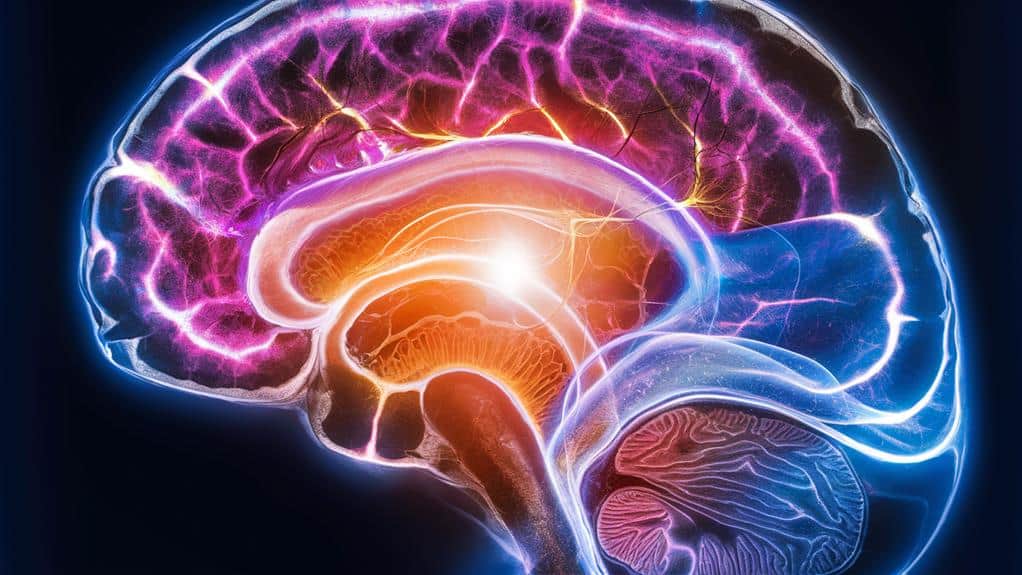
Most mystical experiences share distinct neurological signatures that researchers can now identify using advanced brain imaging techniques.
You’ll find that during these transcendent states, specific regions of your brain – particularly the parietal lobe responsible for your sense of self – show decreased activity.
Meanwhile, your prefrontal cortex, which processes attention and awareness, becomes highly engaged in ways that differ markedly from ordinary consciousness.
When you’re immersed in a mystical state, you’re experiencing what neuroscientists call “self-transcendent awareness,” where the boundaries between your sense of self and the external world become permeable.
Your brain’s default mode network, which maintains your everyday sense of identity, temporarily steps back.
This allows you to access altered states where you’ll feel profound unity with something greater than yourself.
You’ll notice that time perception shifts, and you may experience what researchers term “oceanic boundlessness” – a dissolution of ordinary spatial and temporal boundaries.
These neural patterns aren’t random; they’re consistently observable across different mystical experiences, whether induced through meditation, psychedelics, or spontaneous spiritual encounters.
Origins of Spiritual Experience
These distinct neural patterns lead us to a deeper question: why do humans experience mystical states in the first place?
You’ll find that your brain has evolved to perceive meaning beyond the physical domain, a capacity that’s served humanity throughout its existence. When you enter these transcendent states, you’re tapping into neural networks that’ve been shaped by millions of years of evolution, suggesting that spiritual experiences might serve a vital adaptive function.
You’re carrying within your consciousness the same mechanisms that enabled your ancestors to find meaning in the inexplicable and forge connections beyond their immediate physical reality.
Whether through meditation, prayer, or spontaneous revelation, your brain’s ability to transcend ordinary awareness isn’t just a byproduct of neural activity – it’s a fundamental aspect of human consciousness that’s been preserved across generations.
This capacity for mystical experience might’ve helped early humans cope with existential uncertainty, build stronger communities, and develop more complex systems of meaning.
When you’re experiencing these profound states, you’re engaging with an ancient and deeply embedded aspect of your neurological heritage.
Neural Networks During Transcendence
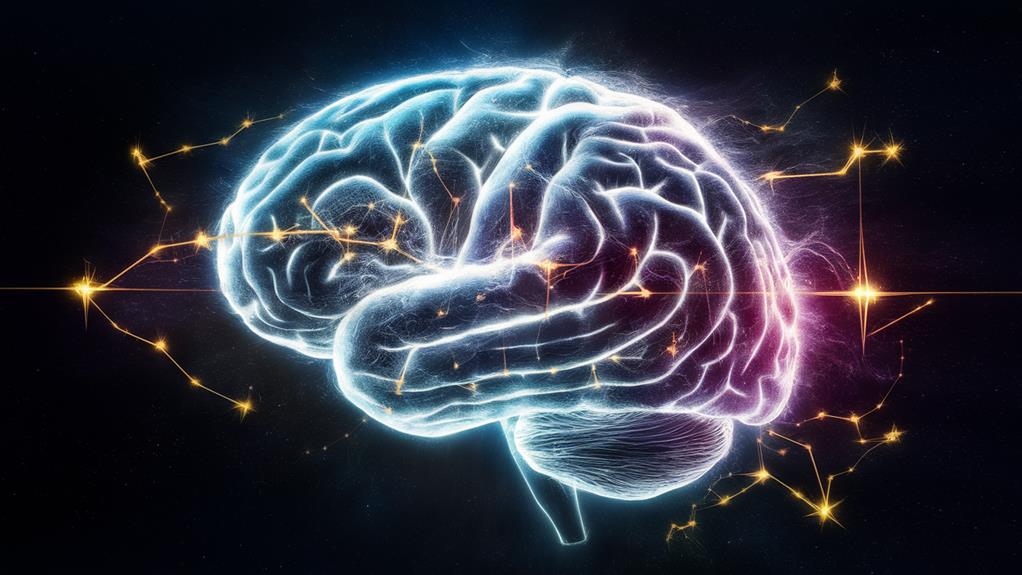
Brain imaging studies reveal distinct neural networks that activate during transcendent experiences. When you enter profound meditative or mystical states, your default mode network – typically active during self-referential thinking – begins to quiet down.
Meanwhile, your brain’s salience network awakens, helping you determine which sensations and emotions deserve your attention as you move beyond ordinary consciousness.
You’ll find that during moments of transcendence, your prefrontal cortex shows decreased activity, loosening your usual grip on time, space, and personal identity. This neural pattern allows you to experience what mystics have long described as “unity consciousness” or “cosmic awareness.”
Your parietal lobe, which normally maintains boundaries between self and environment, becomes less active, creating that sensation of merging with something greater than yourself.
As you dive deeper into transcendent states, your brain’s reward circuits light up, flooding your consciousness with profound feelings of peace and connection.
These neural patterns aren’t random; they’re consistent across different spiritual practices and traditions, suggesting that your brain is naturally wired for mystical experiences that transcend cultural boundaries.
The Default Mode Network
Having explored the broader neural networks involved in transcendent states, understanding the default mode network (DMN) reveals a fascinating paradox of mystical experiences.
You’ll find that when you’re lost in thought, ruminating about yourself or planning your future, your DMN is highly active – it’s your brain’s “me center.” Yet during profound mystical states, this network becomes remarkably quiet.
You’re witnessing a neurological contradiction: the quieting of your self-referential thoughts opens doorways to experiences of unity and transcendence.
When your DMN’s activity diminishes, you’ll often report feelings of boundlessness and dissolution of the ego – those moments when you can’t tell where you end and the universe begins.
This deactivation correlates with the dissolution of typical boundaries between self and others that mystics have described for millennia.
Through meditation, psychedelics, or spontaneous mystical experiences, you’re fundamentally witnessing your own DMN stepping aside, allowing consciousness to flow without the constant narrative of self.
The implications are profound: your deepest experiences of connection and unity may emerge precisely when your brain’s self-referential networks fall silent.
Temporal Lobe and Religious Perception
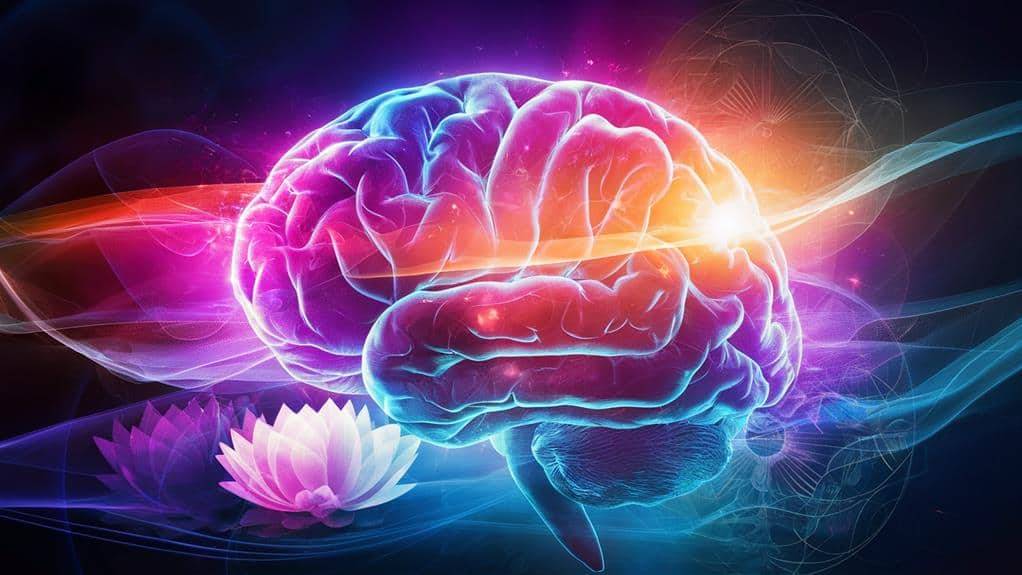
Three key regions within the temporal lobe play crucial roles in shaping religious and mystical perceptions. You’ll find the amygdala processing emotional significance of spiritual experiences, while your hippocampus weaves these moments into meaningful memories and narratives.
Meanwhile, your anterior temporal cortex helps you grasp abstract religious concepts and symbols, transforming raw sensations into coherent spiritual understanding.
When you’re deep in prayer or meditation, these temporal regions work in concert, creating what you might experience as a sense of divine presence or transcendent awareness. You’ll notice how your brain can shift between ordinary perception and profound spiritual states, particularly when these areas become highly active.
The temporal lobe’s unique architecture allows you to attribute significance to ordinary events, potentially experiencing them as signs or meaningful synchronicities. This explains why you might feel a deep sense of meaning during practices like contemplative prayer or religious rituals.
Scientists have observed that people with heightened temporal lobe sensitivity often report more intense spiritual experiences, suggesting that your capacity for mystical perception is intimately tied to these neural networks.
Neurochemistry of Sacred Moments
Sacred moments trigger distinct neurochemical cascades that complement the temporal lobe’s activity. During these profound experiences, you’ll find your brain flooded with neurotransmitters that shape your consciousness and perception of reality.
Your pineal gland releases DMT, while your body’s natural opioids surge through your nervous system, creating that ineffable sense of oneness with the universe you might feel during deep meditation or spiritual practices.
As you navigate these transcendent states, your brain’s serotonin and dopamine systems work in concert, helping you perceive meaning in ways that transcend ordinary consciousness.
You’re experiencing what mystics have described for millennia, but through a neurochemical lens that doesn’t diminish the profound nature of these moments. Your brain’s natural ability to produce these compounds reveals how you’re biologically equipped for mystical experiences.
Even more fascinating is how your gamma-aminobutyric acid levels drop during these states, reducing the filters that normally constrain your consciousness.
This biochemical symphony creates the conditions where you might experience what feels like direct contact with the divine, all while remaining grounded in your brain’s intricate chemical architecture.
Altered States and Brain Activity
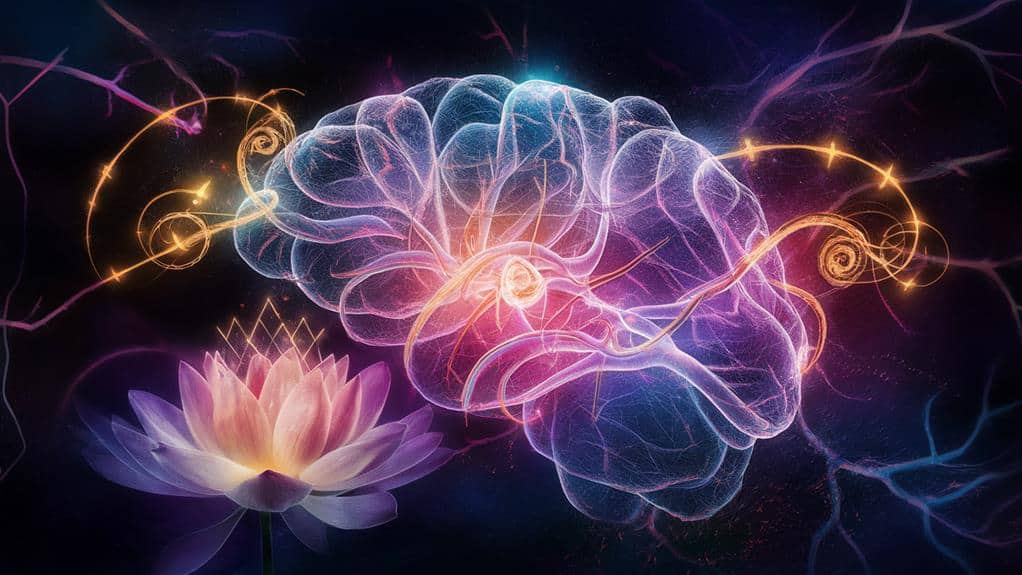
Various altered states of consciousness produce distinct patterns of brain activity that neuroscientists can now measure and map. When you enter deep meditation or experience mystical states, your brain shifts into fascinating configurations – your default mode network often quiets down while other regions light up in synchronized patterns.
You’ll find your prefrontal cortex becoming less rigid in its usual controlling role, allowing boundaries between self and universe to soften.
During profound spiritual experiences, you might notice how your parietal lobe – which normally orients you in space and time – shows reduced activity, contributing to those moments when you feel boundless and eternal.
Your limbic system engages differently too, with the amygdala calming its fear responses while your anterior cingulate cortex heightens its awareness of internal states.
Through modern neuroimaging, you can now witness how your brain’s activity during mystical experiences mirrors patterns seen in deep contemplative practices across cultures and traditions.
This convergence of neuroscience and mysticism reveals how your brain creates doorways to transcendent experiences, showing that these states aren’t merely subjective but have measurable neural correlates.
Meditation Effects on Brain Structure
Brain activity patterns only tell part of the story – long-term meditation actually changes your brain’s physical structure. Through dedicated practice, you’ll develop increased gray matter density in regions associated with self-awareness, compassion, and emotional regulation.
Your anterior cingulate cortex, which helps you maintain focus and make decisions, becomes thicker and more robust. The hippocampus, essential for learning and memory, also shows remarkable growth.
You’ll notice that as your meditation practice deepens, these physical changes manifest in your daily experience. The prefrontal cortex, your brain’s executive center, develops enhanced neural connections, allowing you to observe your thoughts with greater clarity and detachment.
Your amygdala, the brain’s fear center, actually shrinks, reducing your reactivity to stress and anxiety.
What’s particularly fascinating is that these structural changes aren’t temporary – they represent lasting transformations in your brain’s architecture. Scientists have observed these alterations in practitioners who’ve dedicated themselves to meditation for years, suggesting that through consistent practice, you’re not just changing your mind – you’re literally reshaping the physical substrate of consciousness itself.
Scientific Methods Meet Mysticism
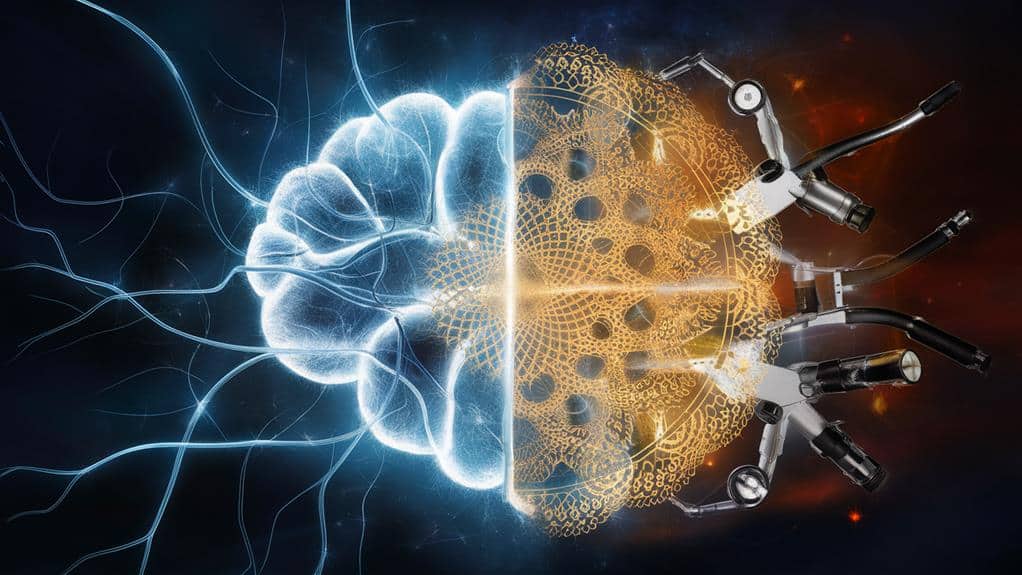
How can science effectively study the deeply personal domain of mystical experiences? You’ll find that researchers have developed sophisticated methods to bridge the gap between subjective spiritual encounters and objective measurements.
Through carefully designed protocols, you’re now able to witness how scientists capture both the quantifiable neural correlates and the ineffable qualities of mystical states.
When you investigate this intersection, you’ll discover that modern technologies like fMRI and EEG machines are being paired with phenomenological interviews, allowing researchers to map both the brain’s activity and the experiencer’s lived reality.
You’re seeing an unprecedented convergence where ancient wisdom traditions meet cutting-edge neuroscience. Through standardized questionnaires and controlled environmental conditions, you can track how mystical experiences consistently affect specific brain regions, particularly the parietal lobe and prefrontal cortex.
As you probe deeper, you’ll notice that scientists aren’t trying to reduce mystical experiences to mere neural firing patterns – they’re developing nuanced frameworks that honor both the objective and subjective dimensions of these profound states.
This balanced approach helps you understand these experiences through multiple lenses, enriching both scientific knowledge and spiritual inquiry.
Future Research Directions
Innovation in mysticism research points to several promising frontiers that could revolutionize our understanding of transcendent experiences.
You’ll find that emerging technologies like high-resolution fMRI and advanced EEG mapping now allow you to peer deeper into the neural correlates of mystical states than ever before. These tools can help you track the precise moments when your consciousness shifts during meditation or prayer, revealing patterns you couldn’t previously detect.
As you explore these new research directions, you’ll discover that artificial intelligence and machine learning algorithms are opening doors to analyzing vast datasets of reported mystical experiences.
You’re now able to identify subtle commonalities across cultures and traditions that were once hidden from view. The integration of virtual reality technologies might soon allow you to study induced mystical states in controlled laboratory settings, while advanced neurochemical mapping could reveal the exact molecular cascades that occur during transcendent moments.
You’re standing at the threshold of understanding how your brain creates meaning from the ineffable, and how ancient practices might be scientifically validated through cutting-edge methodologies that bridge the gap between subjective experience and objective measurement.
Conclusion
You’re witnessing a fascinating convergence of science and spirituality, where your brain’s intricate neural networks illuminate the mechanisms behind mystical experiences. As you explore deeper into this field, you’ll discover how your default mode network, temporal lobe activity, and neurochemical responses shape transcendent moments. By understanding these biological foundations, you’re not diminishing the profound nature of mystical experiences but rather enriching your appreciation of consciousness’s remarkable complexity.



